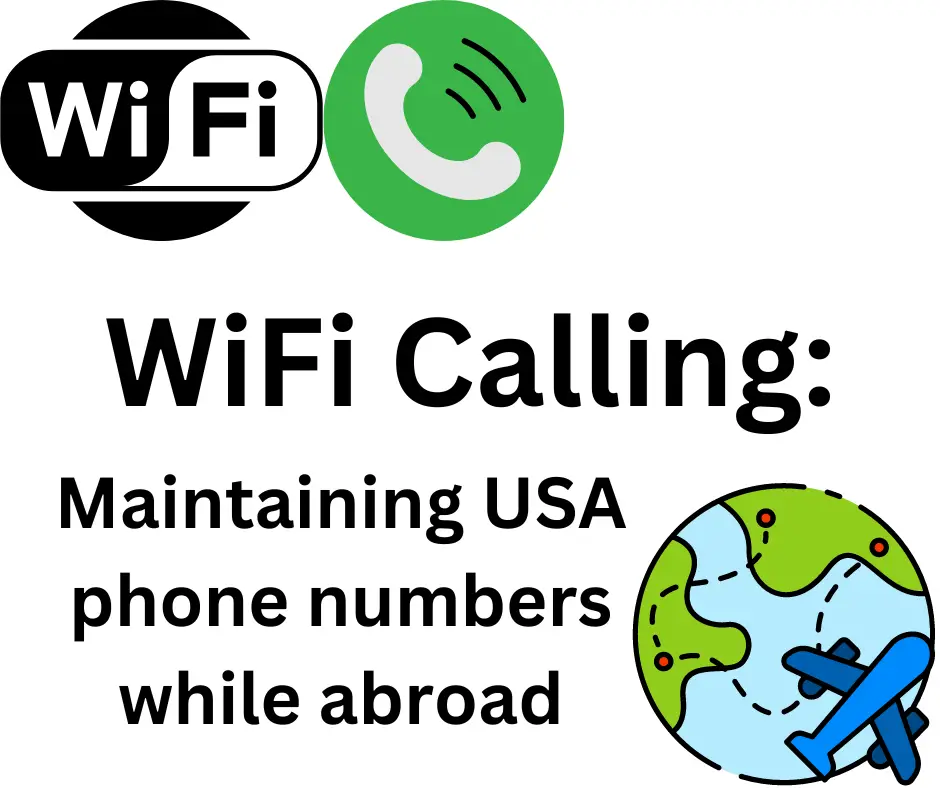; Date: Mon Jul 08 2024
Tags: Digital Nomad »»»»
A key to successful travel abroad is maintaining phone numbers in your home country. While many cell phone providers offer roaming services, this can be very expensive. WiFi Calling is the way to go.

As an American preparing to travel long-term outside the USA, I knew it was important to use the Internet to maintain accounts with financial institutions. This in turn requires sending/receiving text messages or making/receiving phone calls, as your USA phone number, while traveling outside the USA. Since roaming plans tend to be expensive, it's important to know how to make/receive calls or text messages with your USA cell phone account while outside the USA.
Read on to understand why WiFi Calling is the best alternative. The TL;DR high points are:
- International roaming is usually expensive. For AT&T (my cell phone carrier in the USA), roaming costs over $12/day.
- Google Voice can be used from anywhere in the world for USA telephone service. But it is not always supported by financial institutions.
- WiFi Calling is your regular cell phone plan, accessed over the Internet.
A traveler making a long trip outside their home country has one strong reason for maintaining their home cell phone number. Financial institutions often use text messages to a known cell phone number, as a 2-factor authentication technique, to verify identity. Therefore it is crucial for online access to the institution to be able to receive text messages while traveling abroad, and possibly to make/receive phone calls.
Accessing your money is a primary need.
While the information here is primarily for Americans who need to use a USA cell phone account while traveling, (almost) everything we say applies to anyone living in any country.
For a full set of tips to prepare to live outside the USA: How an American can prepare for life as a full-time traveler, inside or outside the USA
Google Voice sure looks tempting
Among the many features Google offers, Google Voice lets us create a USA phone number that's managed by Google. We can either use a web browser or smart phone app to access a virtual telephone. With it we can send/receive text messages, or make/receive phone calls, and listen to voicemail messages.
It's attractive for an American traveler because a Google Voice account can be used from anywhere in the world.
Unfortunately, Google Voice numbers are not always accepted by financial institutions. In my experience, some banks are unable to send text messages to a Google Voice account, and some others do not accept those numbers as your phone number.
One can experiment with Google Voice while inside the USA to see if it will work with your financial institutions. Simply head to google.com/voice and set up a Google Voice account giving you a phone number managed by Google Voice. Configure a bank account to use that phone number for identity verfication or other purposes, and observe what happens. If it works with the first account, keep trying with other accounts.
Many financial institutions (in my testing) do not support for text messages. Therefore, my opinion is that Google Voice is unsuitable for maintaining financial accounts.
Another issue with Google Voice is, well, Google. Google is capturing all kinds of information about stuff we do, in a way which smells of a massive privacy violation. It's a good idea to limit your use of Google services. Good luck with that, since Google is so ubiquitous in our lives. In this case there are simple alternatives that work better for this purpose.
Using other virtual telephone services
There are many other virtual telephone systems. I used Vonage in the late 90s and recall people telling me the audio quality was bad. That Vonage is in business 25 years later indicates that it probably now offers a mature level of service.
I have not used Vonage since, nor have I used any other virtual telephone service.
It's possible one of the the virtual phone services might work well enough to be accepted by banks.
One subculture of virtual telephone services are those which target folks who are, uh, sneaking around behind the backs of their spouse. These services provide temporary phone numbers which can be used over the Internet using a smart phone app. A phone number can be disposed of at any time making it ideal for those hiding their tracks. I tried Hushed, while looking for phone services that could be used from outside the USA, and not for any sneaking purposes. Unfortunately it was unreliable, in that it might require 3 call attempts to have one successful phone call.
Research cell phone provider alternatives in your home country
If you're traveling long-term outside the USA, can you save some $$'s by switching to a less expensive plan?
My AT&T cell phone account, 2 lines with 6GB shared data per month, costs over $80/month. After seeing the service level Vodafone provides, for a fraction of the cost, where we're traveling, I want to ditch AT&T. Too bad I didn't have that idea before leaving the USA. Are we using any of the AT&T service while living in Europe? Nope. That's wasted money.
Before leaving I came across Tello, a cell phone service running on top of the T-Mobile system. Tello's advantages are low rates, and that you can adjust the service level at any time. While traveling my Tello account is set for only 100 minutes of voice per month, and zero data, for a $5/month fee. Upon my return to the USA I'll reconfigure it for a higher service level, and their unlimited voice/data plan is only $30/month.
As is discussed in the next section, Tello supports WiFi calling. They clearly say that instead of offering any roaming plan while outside the USA, to instead use WiFi Calling.
You can get
a discount on Tello service by clicking on this sponsored link.
Using WiFi calling while traveling to make/receive calls or text messages in your home country
The solution I chose is simple -- WiFi Calling. Most cell phones and cell phone plans have this feature. With WiFi Calling, if your phone is connected over WiFi to the Internet, it will use the Internet to make/receive text messages or phone calls.
This means you can use your USA cell phone as if you're in the USA even when you're 10,000 miles away. Your phone calls or text messages do not traverse the cell phone system. Instead, your call goes across the Internet to a WiFi Calling gateway operated by your cell phone carrier. The calls and text messages are routed through that gateway to the regular phone system.
Your cell phone behaves as if you're in your home country. Financial institutions seemingly are unable to tell any difference, and the quality is amazingly good.
I've used this to make/receive phone calls not just with financial institutions, but my mother or other contacts back in the USA.
Be careful when selecting a phone to use with WiFi calling. One phone we bought, a modern Android phone (Moto G8), turned out to be incompatible with AT&T WiFi Calling. That phone is compatible with Vodafone's WiFi calling in the country where we're living, just not with AT&T.
Your cell phone service provider may have a list of cell phones compatible with their WiFi Calling feature. Their customer support documents will have a page about WiFi Calling with instructions on how to proceed.
For an iPhone, WiFi Calling is in Settings under Cellular. If your phone supports WiFi Calling, the feature name will be present. You may be asked to setup E911 information while enabling WiFi Calling.
For an Android phone, in Settings, go to Network & Internet then Calls & SMS. A section will appear labeled WiFi Calling. My phone has dual SIM support, and only one SIM supports WiFi Calling. This SIM is named, and tapping on it takes me to a page allowing me to enable/disable WiFi Calling.
One downside of WiFi calling from a long distance is the time zone difference. Folks calling at mid-day USA time have disturbed me at 3AM local time. They don't know I'm 10,000 miles away and there's 10 hours time zone difference. They're calling when it's convenient for them, but it's sure inconvenient for me.
eSIMs for travelers are not a solution
Many long-term travelers recommend using an eSIM service. They are great at solving a specific issue - your airplane lands and the airport is full of money changer and SIM card sellers that are probably scammers. You need to find a taxi that won't rip you off, and somehow make it to your hotel.
With an eSIM, you can purchase an eSIM for the country before arriving, and it gives cell phone data for Internet access without having to deal with anyone in the airport. With that you can arrange a service to get to your hotel, after which you can make other cell phone arrangements.
But, this article is about using your USA cell phone plan, inexpensively, or at zero cost, while abroad. eSIMs are not a solution to that problem.
I have a cell phone plan with Tello, however, which is installed using an eSIM. It's a regular cell phone plan for the USA, making it a different kind of animal from a service like FlexiRoam.
Summary
Of the many options for making/receiving phone calls from abroad, WiFi Calling is the best choice in my experience. It works/acts just like regular telephone service, because it's operated by your regular cell phone carrier. It's your actual cell phone service accessed over the Internet.










